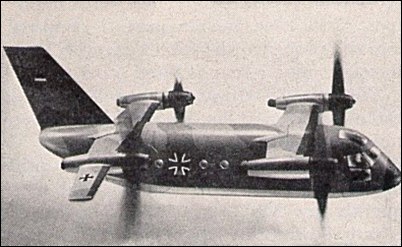|
During the 1960s, a number of VTOL programs were carried out by the West Germany aerospace industry. One of the most interesting was the VFW VC-400, which proposed two tilt-wing installations for VTOL flight.
Both tilt wings were located high on the fuselage, with the front wing positioned directly behind the cockpit. The rear wing was placed in front of the tail assembly. Turboprop engines were located on each wingtip - a most-interesting concept to be sure. S.Markman & B.Holder "Straight Up: A History of Vertical Flight", 2000
Warning: mysqli_connect(): php_network_getaddresses: getaddrinfo for mysql5.zone.ee failed: Name or service not known in /data03/virt15346/domeenid/www.aviastar.org/htdocs/helicopters_eng/fokker_vc-400.php on line 58
Fatal error: Uncaught mysqli_sql_exception: php_network_getaddresses: getaddrinfo for mysql5.zone.ee failed: Name or service not known in /data03/virt15346/domeenid/www.aviastar.org/htdocs/helicopters_eng/fokker_vc-400.php:58
Stack trace:
#0 /data03/virt15346/domeenid/www.aviastar.org/htdocs/helicopters_eng/fokker_vc-400.php(58): mysqli_connect('mysql5.zone.ee', 'd14657sa18989', Object(SensitiveParameterValue))
#1 {main}
thrown in /data03/virt15346/domeenid/www.aviastar.org/htdocs/helicopters_eng/fokker_vc-400.php on line 58
| 




